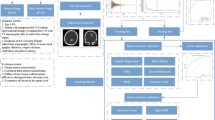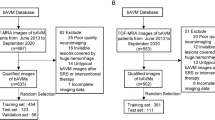Abstract
Purpose
Imaging features of cerebral arteriovenous malformations (AVMs) are mainly interpreted according to demographic and qualitative anatomical characteristics. This study aimed to use angiographic parametric imaging (API)–derived radiomics features to explore whether these features extracted from digital subtraction angiography (DSA) were associated with the hemorrhagic presentation of AVMs.
Methods
Patients with AVM were retrospectively evaluated. Among them, 80% were randomly assigned to a training dataset, and the remaining 20% were assigned to an independent test dataset. Radiomics features were extracted from DSA by API. Then, informative features were selected from radiomics features and clinical features using the Least Absolute Shrinkage and Selection Operator (LASSO) algorithm. A model was constructed based on the selected features to classify the dichotomous hemorrhagic presentation in the training dataset. The model performance was evaluated in the test dataset with confusion matrix-related metrics.
Results
A total of 529 consecutive patients with AVMs between July 2011 and December 2020 were included in this study. After being selected by the LASSO algorithm and analyzed by multivariable logistic regression, three clinical features, namely, age (p = 0.01), nidus size (p < 0.001), and venous drainage patterns (p < 0.001), and four radiomics features were used to construct a model in the training dataset. On the independent test dataset, the model demonstrated a sensitivity, specificity, positive predictive value, negative predictive value, and accuracy of 0.852, 0.844, 0.881, 0.809, and 0.849, respectively.
Conclusion
The radiomics features extracted from DSA by API could be potential indicators for the hemorrhagic presentation of AVMs.




Similar content being viewed by others
References
Brown RD Jr, Wiebers DO, Forbes G, O’Fallon WM, Piepgras DG, Marsh WR, Maciunas RJ (1988) The natural history of unruptured intracranial arteriovenous malformations. J Neurosurg 68(3):352–357
Mohr JP, Parides MK, Stapf C, Moquete E, Moy CS, Overbey JR, Al-Shahi Salman R, Vicaut E, Young WL, Houdart E, Cordonnier C, Stefani MA, Hartmann A, von Kummer R, Biondi A, Berkefeld J, Klijn CJ, Harkness K, Libman R, Barreau X, Moskowitz AJ (2014) Medical management with or without interventional therapy for unruptured brain arteriovenous malformations (ARUBA): a multicentre, non-blinded, randomised trial. Lancet 383(9917):614–621
Jiao Y, Lin F, Wu J, Li H, Chen X, Li Z, Ma J, Cao Y, Wang S, Zhao J (2017) Brain arteriovenous malformations located in language area: surgical outcomes and risk factors for postoperative language deficits. World Neurosurg 105:478–491
Mohr JP, Overbey JR, Hartmann A, Kummer RV, Al-Shahi Salman R, Kim H, van der Worp HB, Parides MK, Stefani MA, Houdart E, Libman R, Pile-Spellman J, Harkness K, Cordonnier C, Moquete E, Biondi A, Klijn CJM, Stapf C, Moskowitz AJ (2020) Medical management with interventional therapy versus medical management alone for unruptured brain arteriovenous malformations (ARUBA): final follow-up of a multicentre, non-blinded, randomised controlled trial. Lancet Neurol 19(7):573–581
Feghali J, Yang W, Xu R, Liew J, McDougall CG, Caplan JM, Tamargo RJ, Huang J (2019) R2eD AVM score. Stroke 50(7):1703–1710
Lawton MT, Rutledge WC, Kim H, Stapf C, Whitehead KJ, Li DY, Krings T, terBrugge K, Kondziolka D, Morgan MK, Moon K, Spetzler RF (2015) Brain arteriovenous malformations. Nat Rev Dis Primers 1:15008
Chen X, Cooke DL, Saloner D, Nelson J, Su H, Lawton MT, Hess C, Tihan T, Zhao Y, Kim H (2017) Higher flow is present in unruptured arteriovenous malformations with silent intralesional microhemorrhages. Stroke 48(10):2881–2884
Rivera R, Sordo JG, Echeverria D, Badilla L, Pinto C, Merino-Osorio C (2017) Quantitative evaluation of arteriovenous malformation hemodynamic changes after endovascular treatment using parametric color coding: a case series study. Interv Neuroradiol 23(6):650–655
Shellikeri S, Bai H, Setser RM, Hurst RW, Cahill AM (2020) Association of intracranial arteriovenous malformation embolization with more rapid rate of perfusion in the peri-nidal region on color-coded quantitative digital subtraction angiography. J Neurointerv Surg 12(9):902–905
Gillies RJ, Kinahan PE, Hricak H (2016) Radiomics: images are more than pictures, they are data. Radiology 278(2):563–577
van Griethuysen JJM, Fedorov A, Parmar C, Hosny A, Aucoin N, Narayan V, Beets-Tan RGH, Fillion-Robin JC, Pieper S, Aerts H (2017) Computational radiomics system to decode the radiographic phenotype. Can Res 77(21):e104–e107
Meyer-Heim AD, Boltshauser E (2003) Spontaneous intracranial haemorrhage in children: aetiology, presentation and outcome. Brain Develop 25(6):416–421
Oulasvirta E, Koroknay-Pal P, Hafez A, Elseoud AA, Lehto H, Laakso A (2019) Characteristics and long-term outcome of 127 children with cerebral arteriovenous malformations. Neurosurgery 84(1):151–159
Reitz M, von Spreckelsen N, Vettorazzi E, Burkhardt T, Grzyska U, Fiehler J, Schmidt NO, Westphal M, Regelsberger J (2016) Angioarchitectural risk factors for hemorrhage and clinical long-term outcome in pediatric patients with cerebral arteriovenous malformations. World Neurosurg 89:540–551
Yang W, Caplan JM, Ye X, Wang JY, Braileanu M, Rigamonti D, Colby GP, Coon AL, Tamargo RJ, Huang J (2015) Racial associations with hemorrhagic presentation in cerebral arteriovenous malformations. World Neurosurg 84(2):461–469
Lv X, Wu Z, Jiang C, Yang X, Li Y, Sun Y, Zhang N (2011) Angioarchitectural characteristics of brain arteriovenous malformations with and without hemorrhage. World Neurosurg 76(1–2):95–99
Burrow AM, Link MJ, Pollock BE (2014) Is stereotactic radiosurgery the best treatment option for patients with a radiosurgery-based arteriovenous malformation score ≤ 1? World Neurosurg 82(6):1144–1147
Kano H, Lunsford LD, Flickinger JC, Yang HC, Flannery TJ, Awan NR, Niranjan A, Novotny J Jr, Kondziolka D (2012) Stereotactic radiosurgery for arteriovenous malformations, Part 1: management of Spetzler-Martin Grade I and II arteriovenous malformations. J Neurosurg 116(1):11–20
Cenzato M, Boccardi E, Beghi E, Vajkoczy P, Szikora I, Motti E, Regli L, Raabe A, Eliava S, Gruber A, Meling TR, Niemela M, Pasqualin A, Golanov A, Karlsson B, Kemeny A, Liscak R, Lippitz B, Radatz M, La Camera A, Chapot R, Islak C, Spelle L, Debernardi A, Agostoni E, Revay M, Morgan MK (2017) European consensus conference on unruptured brain AVMs treatment (supported by EANS, ESMINT, EGKS, and SINCH). Acta Neurochir (Wien) 159(6):1059–1064
Davies JM, Yanamadala V, Lawton MT (2012) Comparative effectiveness of treatments for cerebral arteriovenous malformations: trends in nationwide outcomes from 2000 to 2009. Neurosurg Focus 33(1):E11
Hernesniemi JA, Dashti R, Juvela S, Vaart K, Niemela M, Laakso A (2008) Natural history of brain arteriovenous malformations: a long-term follow-up study of risk of hemorrhage in 238 patients. Neurosurgery 63(5):823–829 (Discussion 829-831)
Stefani MA, Porter PJ, terBrugge KG, Montanera W, Willinsky RA, Wallace MC (2002) Large and deep brain arteriovenous malformations are associated with risk of future hemorrhage. Stroke 33(5):1220–1224
Sahlein DH, Mora P, Becske T, Huang P, Jafar JJ, Connolly ES, Nelson PK (2014) Features predictive of brain arteriovenous malformation hemorrhage. Stroke 45(7):1964–1970
Viñuela F, Nombela L, Roach MR, Fox AJ, Pelz DM (1985) Stenotic and occlusive disease of the venous drainage system of deep brain AVM’s. J Neurosurg 63(2):180–184
Spetzler RF, Martin NA (1986) A proposed grading system for arteriovenous malformations. J Neurosurg 65(4):476–483
Lopes DK, Moftakhar R, Straus D, Munich SA, Chaus F, Kaszuba MC (2016) Arteriovenous malformation embocure score: AVMES. J Neurointerv Surg 8(7):685–691
Raoult H, Bannier E, Maurel P, Neyton C, Ferre JC, Schmitt P, Barillot C, Gauvrit JY (2014) Hemodynamic quantification in brain arteriovenous malformations with time-resolved spin-labeled magnetic resonance angiography. Stroke 45(8):2461–2464
Jin H, Lenck S, Krings T, Agid R, Fang Y, Li Y, Kostynskyy A, Tymianski M, Pereira VM, Radovanovic I (2018) Interval angioarchitectural evolution of brain arteriovenous malformations following rupture. J Neurosurg 131(1):96–103
Shotar E, Pistocchi S, Haffaf I, Bartolini B, Jacquens A, Nouet A, Chiras J, Degos V, Sourour NA, Clarençon F (2017) Early rebleeding after brain arteriovenous malformation rupture, clinical impact and predictive factors: a monocentric retrospective cohort study. Cerebrovasc Dis 44(5–6):304–312
Acknowledgements
NA
Funding
This work was supported by the Natural Science Foundation of Beijing Municipality (grant number 7212007).
Author information
Authors and Affiliations
Corresponding author
Ethics declarations
Ethical approval
This study was approved by the local institutional review board.
Informed consent
The need for informed consent was waived owing to the retrospective nature.
Conflicts of interest statement
We declare that we have no conflict of interest.
Additional information
Publisher's note
Springer Nature remains neutral with regard to jurisdictional claims in published maps and institutional affiliations.
Rights and permissions
Springer Nature or its licensor holds exclusive rights to this article under a publishing agreement with the author(s) or other rightsholder(s); author self-archiving of the accepted manuscript version of this article is solely governed by the terms of such publishing agreement and applicable law.
About this article
Cite this article
Zhu, H., Zhang, Y., Li, C. et al. Quantitative evaluation of the hemodynamic differences between ruptured and unruptured cerebral arteriovenous malformations using angiographic parametric imaging–derived radiomics features. Neuroradiology 65, 185–194 (2023). https://doi.org/10.1007/s00234-022-03030-8
Received:
Accepted:
Published:
Issue Date:
DOI: https://doi.org/10.1007/s00234-022-03030-8




